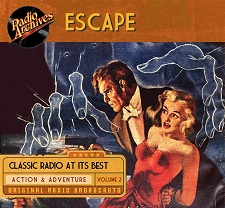
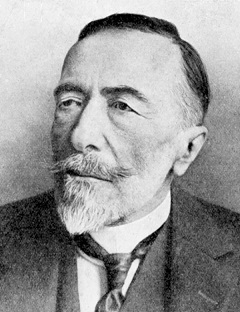 Escape (1947-1954) aired “The Brute” on April 11, 1948 as the show’s 36th episode. Not surprisingly, we have aired many episodes (35+) of this top-shelf program over the past 14 years, the last coming but a few weeks ago. A spinoff and sister show of the highly popular radio program Suspense (1942-62), Escape produced (according to one source) 251 episodes of which 241 were unique stories, plots, or scripts. Escape concentrated on adventure tales, some with an SF/F theme, though the straight adventure tale set in exotic locales was its meat and potatoes. Escape soon established itself with an even more focused approach to action and exotic adventure, dramatizing literary classics (from such as Rudyard Kipling, Sir Arthur Conan Doyle, Edgar Allan Poe, Ambrose Bierce, Nelson Bond, Ray Bradbury, Eric Ambler, Jack London, Joseph Conrad, and others) while at the same time treating its audience to many brand new tales, a fair number of which have become radio classics. In fact, some of Escape‘s original shows were so well written, acted, and produced they were later reincarnated for episodes of Suspense.
Escape (1947-1954) aired “The Brute” on April 11, 1948 as the show’s 36th episode. Not surprisingly, we have aired many episodes (35+) of this top-shelf program over the past 14 years, the last coming but a few weeks ago. A spinoff and sister show of the highly popular radio program Suspense (1942-62), Escape produced (according to one source) 251 episodes of which 241 were unique stories, plots, or scripts. Escape concentrated on adventure tales, some with an SF/F theme, though the straight adventure tale set in exotic locales was its meat and potatoes. Escape soon established itself with an even more focused approach to action and exotic adventure, dramatizing literary classics (from such as Rudyard Kipling, Sir Arthur Conan Doyle, Edgar Allan Poe, Ambrose Bierce, Nelson Bond, Ray Bradbury, Eric Ambler, Jack London, Joseph Conrad, and others) while at the same time treating its audience to many brand new tales, a fair number of which have become radio classics. In fact, some of Escape‘s original shows were so well written, acted, and produced they were later reincarnated for episodes of Suspense.
While strangely not consistently supported by its host network CBS, that rarely gave advance notice of upcoming program titles and moved the show to different times and days willy-nilly no fewer than 18 times over its 7-year run, the show found a faithful audience, and continued to produce well-written scripts with many of the finest actors in radio.
Joseph Conrad (1857-1924, photo above) first saw “The Brute” appear as “The Brute, Tale of a Bloodthirsty Brig,” in the December 1906 issue of The Daily Chronicle. I confess to not having read the story so cannot compare the following dramatization to its literary counterpart. I can report that this script is extremely well wrought by the incomparable Les Crutchfield, and the actor relating the events of the story, Irish-born film and later TV actor Dan O’Herlihy, brings it to robust life. The Brute of the title is an ocean-faring vessel that some believe has been inhabited by an evil force, a malevolent ship that has accounted for the untimely deaths of far too many of those who have set foot on its decks, as either crew or passengers. I found the tale at once riveting and at certain brief moments hair-raising, with the final scene somehow oddly reminiscent of the obsession Captain Ahab had for a whale, that obsession and the man driven by it that a soulless and unforgiving universe would inevitably claim as its own. An apt comparison or not, you be the judge as you listen now to the terrifying—and dare I say not easily forgotten—story of “The Brute.”
(Below: The ship Joseph Conrad)
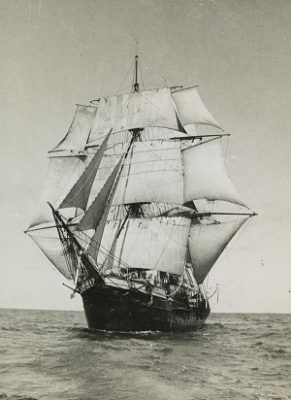
(The CD linked above contains this episode and 19 others.)
Play Time: 29:31
{“The Brute” aired on a Sunday evening in early April of 1948, which meant the neighborhood gang would meet up at the nearby newsstand after school the next afternoon. Having already purchased their favorite SF titles for the month, and after listening to the dark story of “The Brute” the night before, the gang decided to maintain the mood with the following titles: The Phantom Detective (1933-53) was created in direct response to Street & Smith’s popular The Shadow magazine, and while not quite matching the numbers of S&S’s magazine, The Phantom Detective nevertheless managed to attract a healthy readership, one that would easily sustain the magazine for 20 years. It was a bi-monthly in 1948. Popular Detective (1934-53) was one of the top detective pulps for almost 20 years. While it gave its readership relatively standard mystery and detective fare, its stories were written to a high quality by many of the foremost authors in the genre. It too was a bi-monthly in 1948. Thrilling Detective (1931-53) enjoyed the longest run of the three detective pulps pictured below. It held to a steady monthly schedule for most of its 22-year run, switching to a bi-monthly only at the very end of 1945, which schedule it maintained until its demise in 1953. Of note is that while all three of these detective pulps saw their first issues in the early 1930s, they all succumbed in 1953, when many pulps regardless of genre began to cut back on titles, primarily in response to the government’s 1952 antitrust legislation against The American News Company (1864-1957), the country’s largest magazine, comic book, and paperback distributor, as well as periodical wholesaler, but also because ANC and other distributors had decided to quit carrying the pulp magazines because they were no longer profitable, and those who did not, or could not, switch to the more profitable digest format were being dropped. ANC was eventually liquidated and by June of 1957 ceased to exist, leaving print publications of all varieties adrift and searching for new distributors. Because of the onerous and unfeasible restrictions some of these independent distributors placed on the publications they would agree to handle—which many publications could not afford to meet—they were forced to fold, thus leaving the magazine field in a time of messy reorganization that would not see a return to a modicum of normalcy for years to come. As with the other two pulps mentioned here, Thrilling Detective was a bi-monthly in 1948.}
[Left: Phantom Detective, 3/48 – Center: Popular Detective, 5/48 – Right: Thrilling Detective, 4/48]
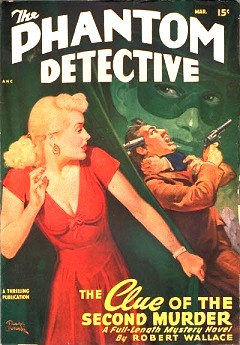
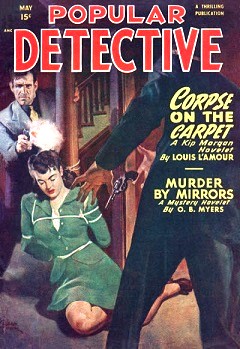
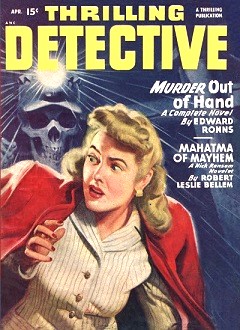
To view the entire list of weekly Old Time Radio episodes at Tangent Online, click here.